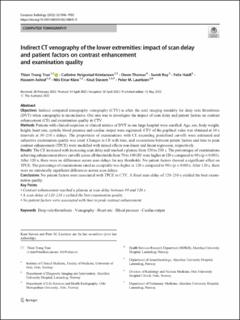| dc.contributor.author | Tran, Thien Trung | |
| dc.contributor.author | Kristiansen, Cathrine Helgestad | |
| dc.contributor.author | Thomas, Owen Matthew Truscott | |
| dc.contributor.author | Roy, Sumit K | |
| dc.contributor.author | Haidl, Frans Felxi | |
| dc.contributor.author | Ashraf, Haseem | |
| dc.contributor.author | Kløw, Nils-Einar | |
| dc.contributor.author | Stavem, Knut | |
| dc.contributor.author | Lauritzen, Peter Mæhre | |
| dc.date.accessioned | 2023-02-20T12:58:55Z | |
| dc.date.available | 2023-02-20T12:58:55Z | |
| dc.date.created | 2022-10-19T11:01:25Z | |
| dc.date.issued | 2022-05-12 | |
| dc.identifier.citation | European Radiology. 2022, 32 (11), 7946-7955. | en_US |
| dc.identifier.issn | 0938-7994 | |
| dc.identifier.issn | 1432-1084 | |
| dc.identifier.uri | https://hdl.handle.net/11250/3052384 | |
| dc.description.abstract | Objectives Indirect computed tomography venography (CTV) is often the next imaging modality for deep vein thrombosis (DVT) when sonography is inconclusive. Our aim was to investigate the impact of scan delay and patient factors on contrast enhancement (CE) and examination quality in CTV.
Methods Patients with clinical suspicion or clinical mimics of DVT in one large hospital were enrolled. Age, sex, body weight, height, heart rate, systolic blood pressure and cardiac output were registered. CTV of the popliteal veins was obtained at 30 s intervals at 30–210 s delays. The proportions of examinations with CE exceeding predefined cut-offs were estimated and subjective examination quality was rated. Changes in CE with time, and associations between patient factors and time to peak contrast enhancement (TPCE) were modelled with mixed effects non-linear and linear regression, respectively.
Results The CE increased with increasing scan delay and reached a plateau from 120 to 210 s. The percentages of examinations achieving enhancement above cut-offs across all thresholds from 70 to 100 HU were higher at 120 s compared to 90 s (p < 0.001). After 120 s, there were no differences across scan delays for any thresholds. No patient factors showed a significant effect on TPCE. The percentage of examinations rated as acceptable was higher at 120 s compared to 90 s (p < 0.001). After 120 s, there were no statistically significant differences across scan delays.
Conclusions No patient factors were associated with TPCE in CTV. A fixed scan delay of 120–210 s yielded the best examination quality. | en_US |
| dc.language.iso | eng | en_US |
| dc.publisher | Springer | en_US |
| dc.relation.ispartofseries | European Radiology;Volume 32, issue 11 | |
| dc.rights | Navngivelse 4.0 Internasjonal | * |
| dc.rights.uri | http://creativecommons.org/licenses/by/4.0/deed.no | * |
| dc.title | Indirect CT venography of the lower extremities: impact of scan delay and patient factors on contrast enhancement and examination quality | en_US |
| dc.type | Peer reviewed | en_US |
| dc.type | Journal article | en_US |
| dc.description.version | publishedVersion | en_US |
| dc.rights.holder | © The Author(s) 2022 | en_US |
| cristin.ispublished | true | |
| cristin.fulltext | original | |
| cristin.qualitycode | 2 | |
| dc.identifier.doi | https://doi.org/10.1007/s00330-022-08841-0 | |
| dc.identifier.cristin | 2062683 | |
| dc.source.journal | European Radiology | en_US |
| dc.source.volume | 32 | en_US |
| dc.source.issue | 11 | en_US |
| dc.source.pagenumber | 7946-7955 | en_US |

